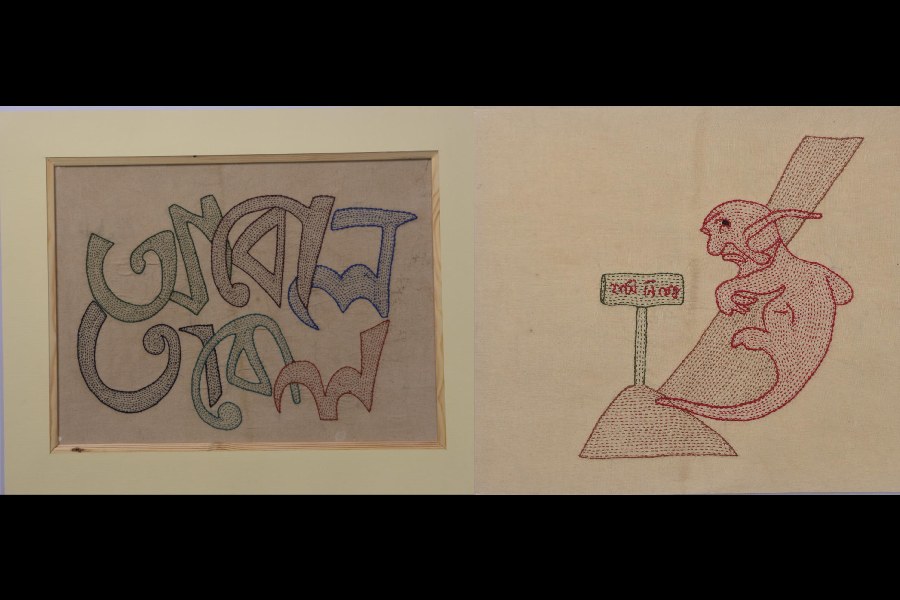Nine years ago was when it all started. A man, a broker of art objects, visited the house of Parimal Ray. His exact question: “Are you interested in buying khuror kol?”
Now, khuror kol is a contraption, a famous literary one, of the creation of the 19th-century Bengali writer Sukumar Ray. Satyajit Ray translated the poem — of the same name — from Abol Tabol, his father’s collection of nonsense verse. Here are some lines describing the khuror kol or uncle’s machine: “Chandidas’s uncle has invented a device/Which is causing everyone to praise it to the skies…/…The outcome, I need hardly add, will change our whole existence/Because we’ll walk for nourishment, and never mind the distance.”
But to get back to our story, the broker wasn’t selling any contraption. On examination, it turned out to be a piece of cloth with the entire poem, Ray Senior’s illustration et al, in intricate needlework. The kind that was atypical to middle-class Bengali families until the middle of the last century.

Collector Parimal Ray.
Bengali women would, alongside patterns of birds, leaves, flowers and popular motifs, stitch idioms and aphorisms. Often, these would be framed and brought out at the time of matchmaking before potential suitors and their families, as testimony of achievement or/and domesticity.
Ray was delighted to be offered the needlework rhyme. You see, he had been a collector since he was a boy and had an eye for the rare and unusual. He had started out his collector’s journey with coins. In 2003, he organised his first solo exhibition showcasing his diverse collections, followed by many more. The 88-year-old says with a chuckle, “But I didn’t give the broker any hint that I was interested because I knew he would then quote a higher price. Acquiring such items for a retired individual like me would become difficult.”
From that point onwards, over the past nine years, Ray collected around 150 such individual pieces, basically all the 53 verses of Abol Tabol and their illustrations.
At no point did the broker let on as to who was behind the needlecraft. The collector states, “Brokers never disclose their sources. It’s an unwritten rule between collectors and middlemen.” One piece in particular caught Ray’s attention. It was a portrait of Sukumar Ray and at the bottom of the frame there was a date — September 19, 1923. Says Ray, “Initially, I wondered what this date signified. It’s not Sukumar Ray’s death anniversary, nor his birth date. Then, I found out that Abol Tabol was first published
on this date.”
Many poems in Abol Tabol satirise the societal and administrative conditions of early 20th-century colonial India, particularly Bengal. By embedding subversive meanings within seemingly nonsensical rhymes for children, Sukumar Ray subverted press censorship imposed by the British administration in India.
In January this year, the Nehru Children’s Museum in Calcutta organised an exhibition of Parimal Ray’s collections to commemorate the centenary of the publication
of Abol Tabol.
Jayanta Kumar Ghose, who is a committee member of the Nehru Children’s Museum and a collector himself, tells The Telegraph, “One thing needs to be clarified concerning collections, the issue of provenance often arises. It can easily be deduced that this work could have been done any time between September 1923 and 2014. So,
we aren’t claiming it as antique. We are merely acknowledging the craftsmanship.”
When Ghose visited Ray some years ago, he chanced upon this artwork. Not long after, he initiated an effort to preserve the pieces by framing them. He says, “In our circle, we fondly call Parimalbabu, the ‘Grandfather of Collectors’. He’s my mentor in this field. My respect for him is immeasurable.”
According to Ghose, with the advent of women’s education and their entry into the workforce, their involvement in handicrafts decreased. But to his practised eye, in this case, all 150 pieces are the work of a single person, most likely a woman. Sukumar Ray’s grandson, filmmaker Sandip Ray, is amazed to learn about this collection. He says, “I was astonished the first time I saw it. The dedication required to transform an entire book into such delicate craftsmanship is beyond comprehension.” Ghose adds, “According to our estimates, the entire project took at least 15 years to be completed.”
The centenary celebration of the publication of Abol Tabol is being observed with various events in different parts of Bengal. Last year, a Durga Puja pandal in north Calcutta showcased a theme inspired by Abol Tabol, books are being released, and so on and so forth. Sandip Ray says, “We knew that in traditional art, such needlework often has to do with images of or verses on various deities. But to imagine Abol Tabol taking up such a space is truly unexpected.”











